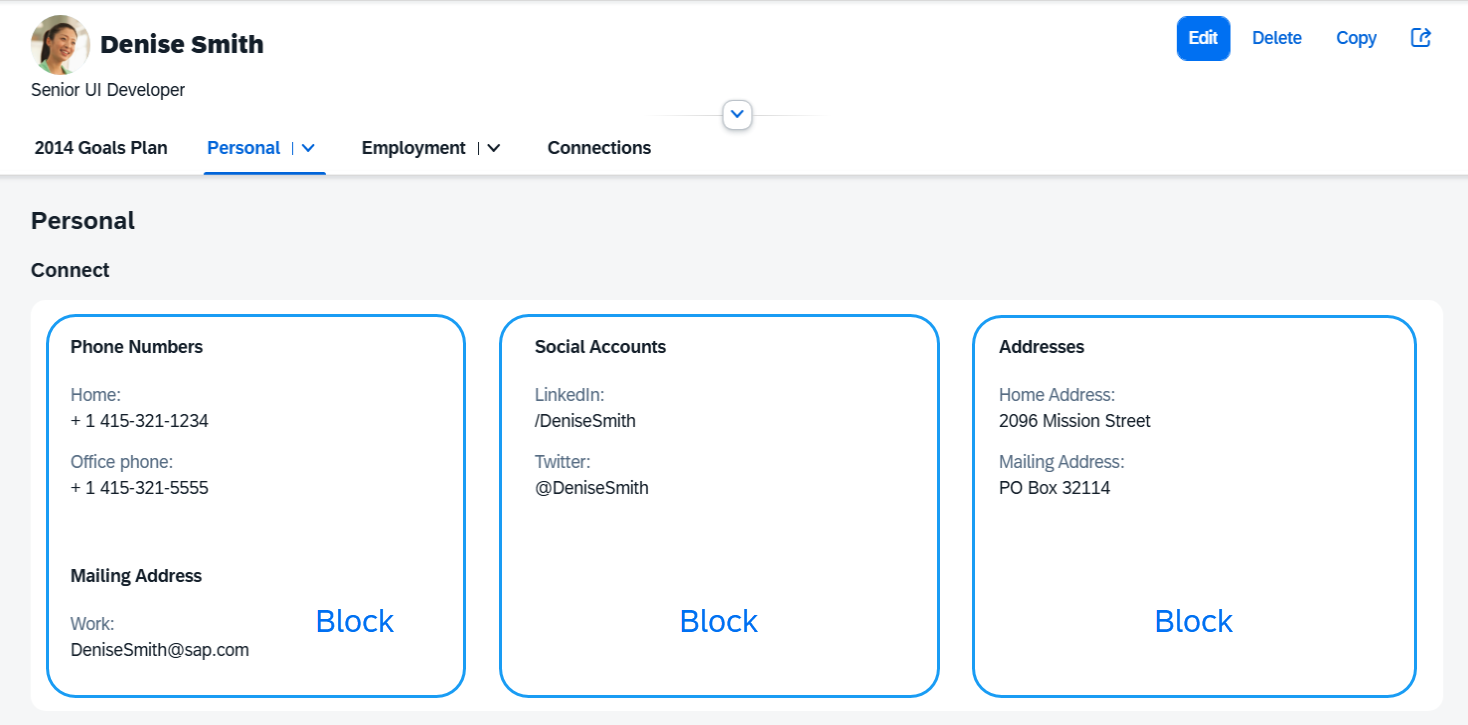Object Page Blocks
ObjectPageLayout control are
organized into blocks.The blocks are used to group the app content that is displayed in the sections and
subsections of the ObjectPageLayout.

To add blocks, use the blocks aggregation of
sap.uxap.ObjectPageSubSection:
<ObjectPageLayout id="ObjectPageLayout" subSectionLayout="titleOnTop">
<sections>
<ObjectPageSection title="Payroll" >
<subSections>
<ObjectPageSubSection title="sub payroll title">
<blocks>
<myNameSpace:myBlock/>
<myNameSpace:myBlock/>
<myNameSpace:myBlock/>
</blocks>
</ObjectPageSubSection>
</subSections>
</ObjectPageSection>
</sections>
</ObjectPageLayout>Any control can be a block. However, the blocks that extend
sap.uxap.BlockBase provide additional features:
-
Lazy loading: Only the blocks that are currently displayed and those in their direct proximity are instantiated
-
Column layout: Blocks provide information to the subsection only on the width they should be using for an optimal experience
Blocks API & Guidelines
Blocks that are used in an ObjectPageLayout have to comply with the
following rules regarding their API. They must:
-
Extend
sap.uxap.BlockBasesap.uxap.BlockBase.extend("<BlockName>", { metadata: { } }); -
Support the modes described in
sap.uxap.ObjectPageSubSectionMode.type-CollapsedandExpanded. For each mode, declare its associated view. It is recommended you use the XML view if no templating is needed:sap.uxap.BlockBase.extend("<BlockName>", { metadata: { views: { Collapsed: { viewName: "<collapsedViewName>", type: "XML" }, Expanded: { viewName: "<expendedViewName>", type: "XML" } } } }); -
Come with their own controller (if needed). This controller should just react to the internal events of the block, as the
ObjectPageLayout's own controller should only manage the page and its sections and subsections. -
Follow the SAPUI5 naming guidelines: see Related Information
-
Use the
modelMappingmechanism to declare distinct model per logical entity.
Let's consider an Employee Goals block that displays an employee together with his or her goals.
One Employee model for the employee entity:
<Text text="{Employee>FirstName}"></Text>One Goals model for the goal collections:
<List items="{Goals>}">In one backend service, goals may be a navigation property of employees, but in another this may not be the case. For this reason, when implementing the Employee Goals block, you should use two distinct models in the block views.
An app wants to use the Employee Goals blocks described
above. These are therefore embedded into a page that has a model named
ApplicationModel, in which Goals are a
navigation property of
employees:
<EmployeeGoals>
<mappings>
<uxap:ModelMapping externalModelName="ApplicationModel" externalPath="/Employee('121')" internalModelName="Employee" />
<uxap:ModelMapping externalModelName="ApplicationModel" externalPath="/Employee('121')/Goals" internalModelName="Goals" />
</mappings>
</EmployeeGoals>A second app uses the same blocks, but in its service, Goals and
Employees are unrelated
entities:
<EmployeeGoals>
<mappings>
<uxap:ModelMapping externalModelName="ApplicationModel2" externalPath="/Employee('121')" internalModelName="Employee" />
<uxap:ModelMapping externalModelName="ApplicationModel2" externalPath="/Goals" internalModelName="Goals" />
</mappings>
</EmployeeGoals>BlockBase interprets this in the following order:
-
Looks for a model with the name specified in the
externalModelName. -
Sets this model on itself with the name specified in the
internalModelName. -
Creates a context corresponding to the path.
This model mapping is not mandatory as models used in a view can also be provided by standard SAPUI5 techniques (model inheritance, setModel).
Standard Block Implementation
The standard block implementation is to extend the
sap.uxap.BlockBase control and inherit the default
implementation of setMode and rendering. setMode
in BlockBase supports two different ways of building blocks:
-
Single view blocks: A single XML view is used for all layout modes. This XML view should be named
<name>.view.xml. -
Multiple view blocks: Different views are provided for the different layout modes.
-
These views should be added in the
viewssection of the block metadata (this section is added by theBlockBaseclass). -
For each mode, the
BlockBaseclass must declare a view name and type:sap.uxap.BlockBase.extend("<BlockName>", { metadata: { views: { Collapsed: { viewName: "<collapsedViewName>", type: "XML" }, Expanded: { viewName: "<expendedViewName>", type: "XML" } } } });
-